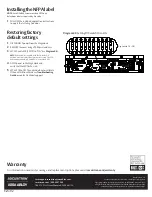
11
of 12
10
of 12
Test 1 – Verifying
correct startup
The DEM680E should be calibrated with
a non-zero nuisance delay setting.
1
With the door closed
, the LED should be GREEN,
indicating that it is active (see
Diagram 36
).
• If the LED is RED or AMBER, stop and consult
the
Troubleshooting Guide
to correct.
Test 2 – Verifying
door security
2
With the door closed
, PUSH against the face of
the door WITHOUT releasing the primary locking
mechanism (e.g., an exit device or cylindrical/mortise
door lock). The nuisance alarm should not sound if
the door is adjusted properly (see
Diagram 37
).
• If the nuisance alarm sounds
, there is too much door
movement. The primary locking mechanism must be
adjusted to reduce excessive door travel. Excessive
movement will cause the DEM680E to go into alarm
and unlock when the door is pulled from the unsecure
side. Make necessary corrections and repeat Test 2.
Test 3 – Verify nuisance
alarm function
3
UNLOCK the primary locking mechanism (push bar or turn
handle) and attempt to push the door open. The nuisance
alarm should sound (see
Diagram 38
). Close the door before
the nuisance interval expires to prevent the alarm state.
• If the nuisance alarm does not sound
, the strike
assembly screw may have been overtightened.
Overtightening prevents the door from traveling past
the nuisance threshold. Refer to “No Alarm” in the
Troubleshooting Guide
and
Diagram 14
which shows
proper adjustment of the strike assembly screw.
Test 4 – Verify countdown
alarm & free egress
4
UNLOCK the primary locking mechanism and attempt to
open the door. The nuisance alarm should sound along
with a flashing strobe. Maintain pressure on the door
until the alarm becomes steady; the DEM680E is now in
alarm state. The door should open in 15 or 30 seconds,
depending on the exit and nuisance delay settings. At
the end of the alarm interval, the LED should turn red,
and the door should freely open. (see
Diagram 39
).
*After testing, close the door and perform a reset. After
reset, the strobe should turn off and the LED should change
from red to green. VERIFICATION IS COMPLETE.
MAGNALOCK OPERATIONAL TESTS
Troubleshooting Guide
TROUBLE INDICATOR
POSSIBLE CAUSES
POSSIBLE SOLUTIONS
Solid RED
• Two bond sensor failures*
• Supply voltage < 8.5 VDC
• Two bond sensor failures*
• Ensure bond sensor connectors are properly seated
• Check power supply voltage
• Ensure bond connectors are properly seated
Solid RED with
Audible Alarm
• Open door
• DPS failure*
• Attempting to calibrate with two bond sensor failures*
• Strike tray installed upside down
• DPS magnet missing from strike tray
• Close door
• Ensure DPS connector is properly seated
• Ensure bond connectors are properly seated
• Ensure that the strike tray is mounted
with alignment tabs facing up
• Check strike tray for damage, replace if needed
Solid AMBER
• Door sag
• Obstructed strike/magnet face
• Supply voltage < 10.8 VDC
• Single bond sensor failure*
• Magnet disconnected or magnet cable wire broken
• Verify that the strike label has been removed
• Recalibrate
• Check for obstructions between strike and magnet
• Clean face of strike and magnet. Recalibrate
• Check power supply voltage
• Ensure bond connectors are properly seated
• Make sure magnet connector is properly
seated or repair magnet cable wire
Flashing RED
• Factory reset
• Ensure SW10 is in the OFF position
LED off
• LED disabled by SW1
• Supply voltage < 5 VDC
• Turn SW1 to the ON position
• Check power supply
Intermittent alarm
• Over-tightened strike screw
• Unscrew strike screw 1/2 turn at a time
until alarm sound is constant when door
is pushed (Recalibrate lock after each
adjustment and repeat
Install Verification
)
No alarm
* Failure means that the circut cannot detect a signal from the sensor. Check that the sensor connectors are properly
seated and inspect sensor wires for damage. Call Technical Support if replacement is needed.
Diagram 36 Indicator light displays
Diagram 37
Diagram 39
Diagram 38

























